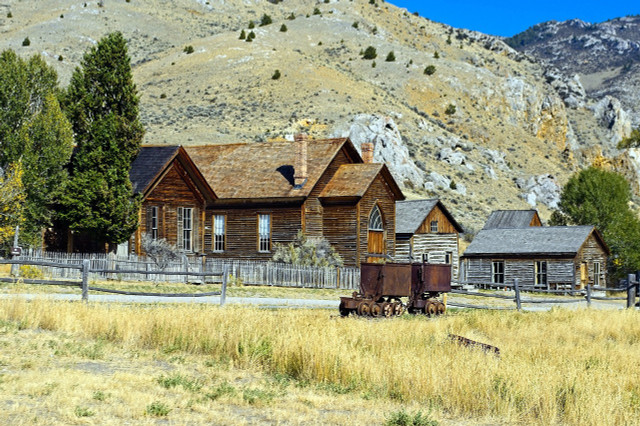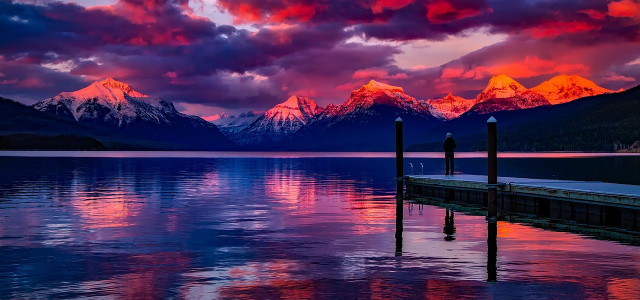Montana’s spectacular national and state parks are a must-see for any avid camper. Here we outline some of the best spots for camping in Montana.
Montana is truly a camper’s paradise and presents some of the most spectacular outdoor experiences in the country. Glacier National Park is an obvious choice for scenic campsites, but camping in Montana extends far beyond the park’s borders.
Whether it is historic ghost towns from the Old West, soaring mountain peaks, verdant forests and grasslands, intriguing caverns, or gorgeous lakes and rivers, Montana has a campground that will suit anyone’s tastes. So pick out your scenic camping spot, set up your tent, and enjoy some of the best spots for camping in Montana.
1. Apgar Campground, Glacier National Park



(Foto: CC0 / Pixabay / CarinaChen)
Apgar is the largest campground in Glacier National Park and one of its most popular. The campground can accommodate nearly 200 tents and/or RVs and is located near the magnificent Lake McDonald. The site offers a wealth of outdoor activities along with some of the best scenery in the country.
2. Lewis and Clark Caverns Campground



(Foto: CC0 / Pixabay / picman2)
Lewis and Clark Caverns are some of the largest known limestone caverns in the Northwest. The only way to see the caverns is through a guided tour offered by the park. The nearby campground offers more than 40 sites spread across a tranquil grassy valley. Campsites can easily accommodate tent and RV camping, and three cozy cabins are available to rent.
3. Camping in Montana: Bannack State Park



(Foto: CC0 / Pixabay / MikeGoad)
Bannack State Park is a real treat for history buffs, boasting a lovingly preserved ghost town from Montana’s first gold rush back in 1862. Guided tours are available from the visitor center. Camping is distributed across two separate campgrounds with a total of 24 sites on offer.
4. Crystal Lake Campground



(Foto: CC0 / Pixabay / BigBearCabins)
Crystal Lake Campground is found on the banks of its namesake, with 28 campsites available for outdoor adventurers. This hidden gem of a camping spot in Lewis and Clark National Forest offers incredible views and some of the best hiking trails in the region.
5. Camping in Montana: Many Glacier Campground



(Foto: CC0 / Pixabay / 12019)
Many Glacier Campground is another highly sought-after spot for camping in Montana and provides nearly 100 camping sites. Breathtaking scenery can be seen in every direction, with the nearby Swiftcurrent Lake being a real highlight for visitors. There is a host of wonderful hiking trails easily accessed from the campground itself, in particular the stunning Grinnell Glacier Trail, which is an absolute must-do for anyone visiting Many Glacier Campground.
6. Mammoth Campground, Yellowstone National Park



(Foto: CC0 / Pixabay / cocoparisienne)
The Mammoth Campground is set close to the intriguing Mammoth Hot Springs area of Yellowstone. This part of the national park is also one of the oldest areas of Yellowstone, a history reflected by the still-standing Fort Yellowstone. Mammoth Campground boasts 85 campsites that are available all year round, making it the only campground in the entire park where you can go winter camping. The sites can accommodate both tent camping and small RVs.
7. Camping in Montana: Spire Rock Campground



(Foto: CC0 / Pixabay / 12019)
Spire Rock Campground in Custer Gallatin National Forest is ideal for those in search of more adventurous surroundings. The trailhead for the Storm Castle Peak hike is less than a mile from the campgrounds, which provide 19 campsites in a shady forest setting. The dirt road accessing the campground will suit smaller recreational vehicles, but full-blown RVs will likely encounter some difficulties.
8. Holland Lake Campground, Flathead National Forest



(Foto: CC0 / Pixabay / 12019)
Holland Lake Campground is another great spot for camping in Montana as it offers visitors around 40 campsites with easy access to the stunning lake itself. The 400 acres of Holland Lake make it ideal for boating and fishing enthusiasts, and hikers will love the challenge and beauty of the nearby Holland Falls National Recreation Trail.
Camping Sustainably



(Foto: CC0 / Pixabay / Pexels)
No matter where you pitch your tent for the night, it’s important to camp in a respectful and sustainable manner.
- Pay Park Entry Fees: Prevent the chance of a hefty fine and support the local ranger services in their efforts to protect and conserve the natural environment as well as keep the park safe and all amenities well-maintained.
- Camp in Designated Areas: keep your impact to a minimum and preserve the space for future generations to enjoy.
- Respect Flora & Fauna: National parks and reserves exist to preserve and nurture our precious natural wonders, so interfering with or damaging local flora and fauna is an absolute no-no.
- Take Out What You Bring In: Take all garbage, waste, and gear with you after your visit to any park or campground. Leaving no trace should be the cornerstone of any camping experience you undertake and will ensure our pristine national reserves remain that way.
- Pack Organic Food & Natural Body Products: Packing organic food and natural body products such as soaps and shampoo for longer camping expeditions means the potential for chemicals and other pollutants from entering the ecosystem and fragile waterways.
- Bring Your Own Snacks & Meals: By taking homemade meals and snacks in your own containers will reduce the chance of plastic and paper waste entering the environment. You will also be reducing the amount of work you will need to do cleaning up your campsite before you leave.
- Use Reusable Dishes & Utensils: Disposable plastic or paper plates and utensils are entirely unnecessary since there are plenty of nifty camping meal kits and utensils that you can purchase and use long-term if you are an avid camper. Failing that, taking along your own kitchen dishes and utensils is far better than using disposable plastic products and leaving your trash behind.
Read on:
- The 10 Best Oregon State Parks for Camping: Coastal, Near Portland, South, and East
- Campfire Pizza Recipe: Vegan & Customizable
- 10 Tips on How To Make Camping as a Family a Success
Do you like this post?









